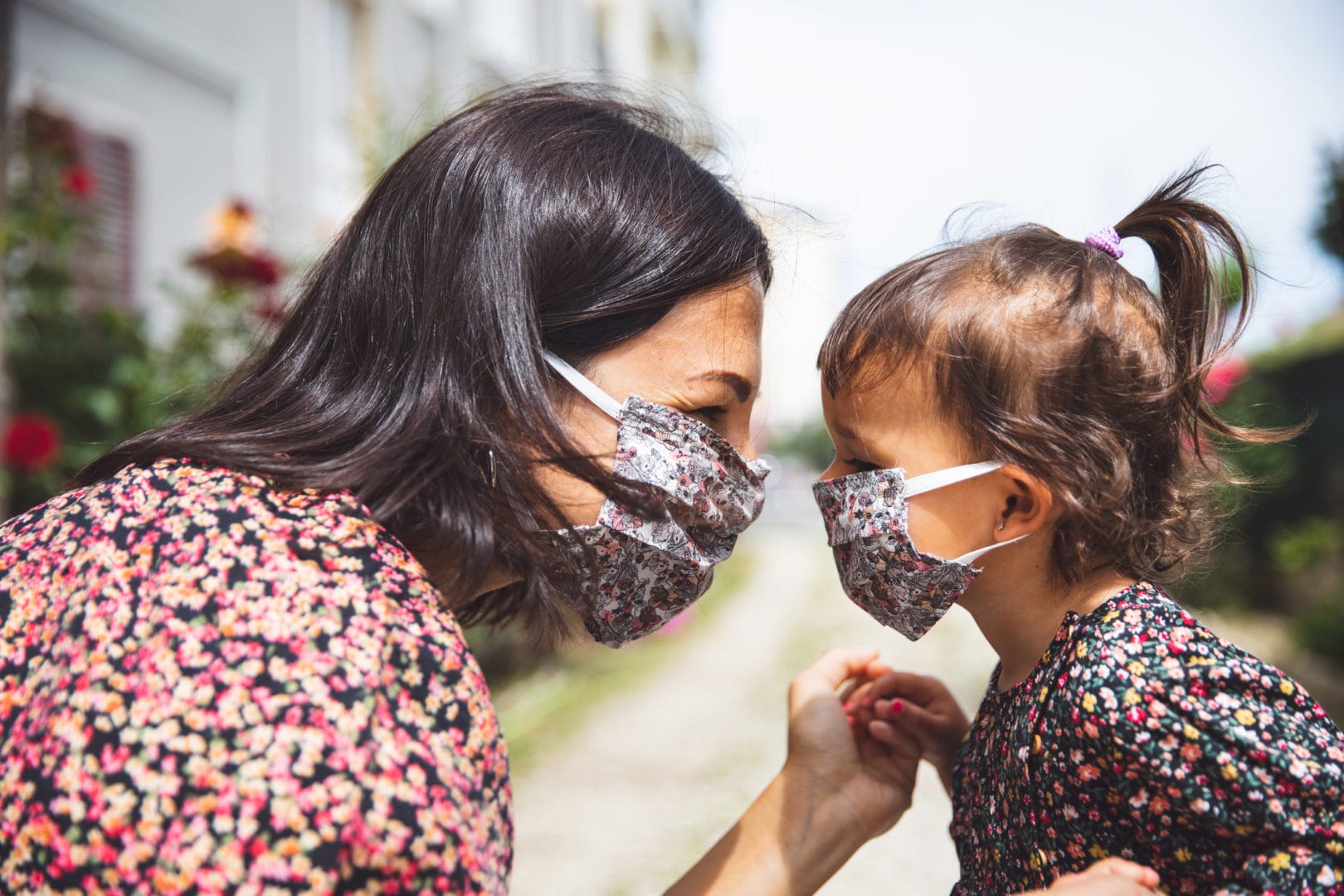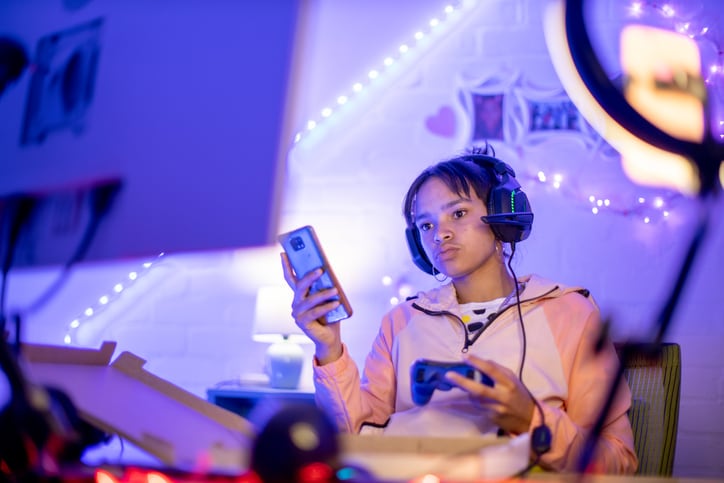Ever since the novel coronavirus arrived in the U.S., parents have been faced with an onslaught of messages about what is and isn’t safe to do while living through a pandemic. Stay home. Practice social distancing. Wash your hands for at least 20 seconds. And now, wear a mask.
U.S. health officials recommend everyone over the age of 2 years old cover their face when out in public to help slow the spread of coronavirus. However, scary stories and misleading claims about masks online have left some parents understandably confused about what is safest for their child.
Here are five of the most common rumors going around to parents about face masks — and what medical experts say about the safety and science of kids wearing them.
Myth #1: Making kids wear masks will mess them up emotionally
Short answer: FALSE. There’s no evidence masks are psychologically damaging.
Long answer: While some parents worry that wearing a mask — or seeing lots of other people wear them — will traumatize their kids in some way, there’s no evidence that that’s true. In fact, masks may actually help protect mental health.
“Mask-wearing will allow children the ability to interact with their peers safely,” says Dr. Hela Barhoush, a pediatrician in Secaucus, New Jersey. “Though it may take some getting used to, this social engagement is actually integral to the psychological well-being of children.”
Even so, if you’re worried your child will be anxious or fearful about mask-wearing, there are things you can do and say to make them less scary. For example, Dr. Florencia Segura, a pediatrician at Einstein Pediatrics in Vienna, Virginia, recommends parents normalize the behavior by wearing the mask at home and use positive language to reassure them that wearing a mask is a good thing because it keeps them and others safe.
How you respond to mask-wearing can also affect how your child responds to it.
“Remember, younger children are little sponges, and they key into parents’ emotions,” says Dr. Corey Fish, a pediatrician and Chief Medical Officer at Brave Care in Portland, Oregon. “If you’re feeling scared and stressed, the kiddos will pick up on that.”
Myth #2: Masks don’t allow kids to get enough oxygen
Short answer: FALSE. Your child can get enough oxygen while wearing a mask.
Long answer: Breathing through a mask might feel a little strange at first, but children shouldn’t have any problem getting enough oxygen while wearing one. That’s because the kinds of cloth face coverings recommended by the Centers for Disease Control and Prevention (CDC) don’t form a tight seal around the nose or mouth and wouldn’t restrict oxygen to the point of hypoxia (a condition where the brain doesn’t get enough oxygen), Fish says.
Even if it were possible for masks to deprive kids of oxygen, Fish says there would be obvious warning signs.
“Your child would be fussy and upset well before oxygen levels dropped to that point in their bodies,” he says.
That said, Fish warns that children shouldn’t wear a mask if they have trouble breathing during activities like vigorous exercise. If your child is clearly struggling to get enough air, they should take off the mask right away.
Similarly, due to the risk of suffocation, some people should never wear a mask, according to Barhoush, including:
-
Young children under 2 years old.
-
People of any age who can’t take the mask off on their own (for example, because they are asleep or have physical limitations).
-
Anyone who has trouble breathing.
Myth #3: Masks can lead to carbon dioxide poisoning in kids
Short answer: FALSE. Wearing a mask won’t lead to carbon dioxide poisoning.
Long answer: Just like wearing a mask won’t deprive kids of oxygen, it also won’t cause kids to get too much carbon dioxide. This is a common misconception, Segura says.
“Carbon dioxide is a gas, and its molecules are so small that they easily pass right through masks,” she says. The idea that kids would breathe all that carbon dioxide back in and develop hypercapnia (carbon dioxide poisoning) just isn’t backed by science.
Myth #4: Kids who wear masks will get even more sick if they contract the virus
Short answer: FALSE. Wearing a mask won’t worsen symptoms in a child who has or is carrying the virus.
Long answer: If your child already has the virus and you’re not aware, wearing a mask won’t worsen their symptoms, contrary to what some social media posts might claim. Fish says if the virus is inside the child’s body in the first place, breathing it back in right away won’t make them any sicker or “restart” their infection.
Masks work by trapping the virus when it leaves the nose or mouth so that it won’t go into the air where it can be inhaled by other people.
What can be risky is touching the mask with your hands and then touching other objects or vice versa. If your child is constantly touching the mask and then handling things (like toys or playground equipment), it could increase their chances of passing the virus onto others. Likewise, if kids touch contaminated objects (like door handles with the virus on it) and then touch their masks, they could breathe the germ in that way, too.
“It’s important to teach children the proper techniques of mask-wearing,” Barhoush says. For example, remind them to not touch the mask while it’s on their face, put it on and take it off by the loops (never the front), and to wash their hands with soap and water for at least 20 seconds or apply alcohol-based hand sanitizer before and after touching the mask.
If a child is having a hard time keeping their hands off of their masks or face, Barhoush recommends not forcing mask-wearing. Instead, parents and caregivers should rely more on other prevention strategies like social distancing.
Myth #5: Kids don’t get sick from COVID-19, so they don’t need to wear masks
Short answer: FALSE on two counts. 1) The risk of complications from COVID-19 is lower in children, but it’s not zero. 2) Kids should wear a mask to protect the people around them.
Long answer: While COVID-19 is often mild in children, it isn’t always. Kids with underlying health conditions or weakened immune systems, such as those going through cancer treatment or who have serious heart conditions, are at higher risk for getting seriously sick or dying from COVID-19, according to the CDC.
In very rare cases, it’s also possible some children infected with the virus that causes COVID-19 could go on to develop a rare, potentially deadly condition called Multisystem Inflammatory Syndrome.
Even if you’re not all that worried about your child getting seriously sick with COVID-19, experts say that’s not really the point of mask recommendations.
“We know from many recent studies that children can be asymptomatic carriers of COVID-19, and their viral loads were just as high as those of symptomatic children,” Segura says. In other words, it is possible for kids to become infected with the virus and never look or feel sick, yet spread the virus to people around them — some of whom might go on to develop serious cases.
She worries that asymptomatic carriers complicate efforts to control the COVID-19 pandemic because they could be spreading the virus without realizing it, which is why wearing masks is so crucial.
If you have additional questions or concerns about whether wearing a mask is safe for your family, talk to your healthcare provider or visit authoritative sources like the American Academy of Pediatrics and the CDC.






